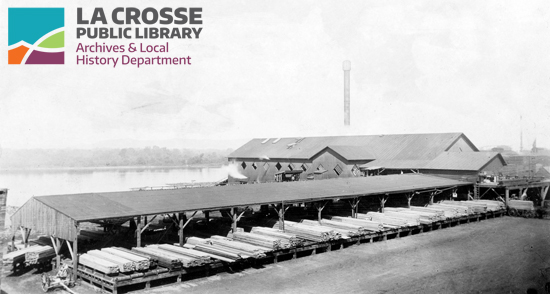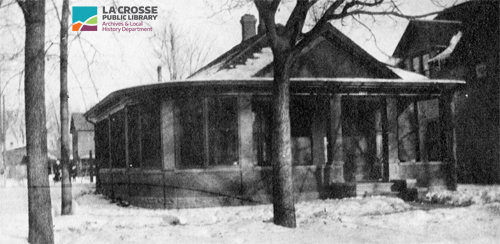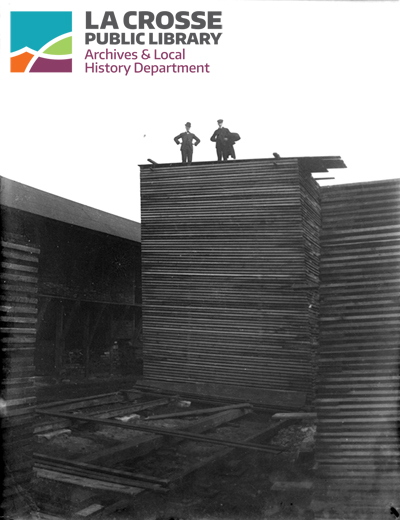
Houses for a Hundred Dollars
(written by Dr. Les Crocker, Emeritus Professor of Art History)
People are always curious as to what something cost in the “good old days.” In an earlier blog I talked about sawmill lumber, nails and immigrants. This blog explores what one of these houses cost. In 1888 a local contractor talked to a newspaper reporter about local building costs.
LA CROSSE IS THE PLACE TO BUILD CHEAP HOUSES
A Man Who Knows All about It, Tells What it Costs to Build in the Gateway City—There's a chance for the Workingman Here, as there is no Town in the Northwest That Can Offer Better Inducements than Our Flourishing City.

Stacks of sawn lumber sit in the sheds of the C. L. Colman Lumber Company, La Crosse, Wisconsin.
During the last five years La Crosse, the city of sawmills, has experienced a wonderful building activity. People who come back here now, after several years absence, are astonished at its growth, and stand amazed that such extensive improvements have been made with so little stir or excitement. Even now, although building is not particularly active, it requires more energy than the common citizen possesses to keep up his knowledge of building news. He goes away for a week and returns to find a dozen or more new houses started in his neighborhood. They are easily and quickly erected and best of all, cheaply. Perhaps there is no town in the Northwest that can offer better inducements for house-building than La Crosse. Here the day laborer, the mechanic, the railroader, the clerk or young business man, or in fact, anyone with little capital, can build a house all his own. He finds himself surrounded by an industrious class of citizens, who, like himself, had little to start out when the first undertook the responsible duties of citizens and property owners. A few months or a year or two's savings of an industrious and energetic man will build him a home, warm, cozy and comfortable. If he has good prospects and is sober and reliable, he can build his home and pay for it as may save his money afterward. The different building associations and business men are ever ready and willing to advance money for this purpose to honest applicants.
On the subject of home building in La Crosse a Republican and Leader Reporter had an interesting talk with Mr. O.G. Huff, the well-known builder of La Crosse. Mr. Huff has had a great many years' experience in building, though he has resided in La Crosse less than two years.

Many modest homes were located in the Goosetown neighborhood which residents described as a melting pot of ethnicities, religions and ideas. Pictured here is a very small cottage at 517 North 13th Street in 2015. Photo courtesy of Dave Kranz.
“A very fair two-room house,” said Mr. Huff, “can be built here for about $230. This will make a snug little cottage 24 x 16 feet in size, one story high. It will be all complete, clear down to painting. A few dollars more will divide off another room, making it a three-room house.”
The different items of expense on this house are as follows:
Foundation $ 25.00
Lumber 65.00
Carpenter work 65.00
Plastering 40.00
Hardware 15.00
Painting 20.00
Total $230.00
If you want to put in a little more money you can, by an addition of $100 to these figures add another large room and also ornament the outside somewhat.

A modest house once located at 1023 South 2nd Street
The sum of $400 will build you a two story 16 x 24 with five rooms—three down and two upstairs. For $20 you can put a porch in front. For this house the different items of expense are:
Foundation and Cellar $ 40.00
Lumber 110.00
Carpenter Work 115.00
Plastering 70.00
Hardware 25.00
Painting 40.00
Total $ 400.00
“Should your wife be a lover of house plants, you can put in a bay window for $30 or more, and you can put up a summer kitchen, without plastering, for $20. The very nicest Summer kitchen there is can be built for $50. It is sixteen feet square, and has pivotal blinds all around. It is airy and convenient, but there are not many of them in use here.”
“Going into the business a little heavier, you can build a nice eight roomed cottage for $700. It will have a hall and stairway in front and a woodshed besides, four rooms downstairs, four upstairs and a cellar.”
“A ten-roomed house will cost about $1000. this will build an elegant building. It would give you a parlor 14 x 12, a sitting room 13 x 16, a kitchen 12 x14 a pantry 6 x 7, a bathroom 4 x 7, a bedroom 11 x 10, a porch and a vestibule in front and a porch at the back door; upstairs there will be three good-sized rooms.”
“What grade of lumber do your figures refer to?”
“Third Grade. That is the grade with which nearly every house in North La Crosse is built, and it is plenty good for building purposes. We pick out the best of it and use for finishing. It costs about $15 per thousand [board feet]. For shingles, the best you can use are the cheapest. They cost from $1.25 to $1.75 while the better class costs $4.00. The culled shingles will last three times as long as the more expensive article, because they do not split.”
“What does it cost to veneer a house with brick?”

This modest home stood at 1125 Vine Street. Its upgrades included a brick veneer and a curved front porch.
“Well you can figure that up at about $20 per room. Your ten-room house will cost $200 to veneer and so on down. A good little barn, for a horse and a cow, will cost about $50.”
“What is the cheapest two room cottage you can put up?”
“Well sir. I put up a house for a man last Summer and the whole thing cost the owner just $100. It had two large rooms, a porch in front and was painted inside and out. It was built of two-inch ploughed plank set up perpendicularly. It makes a warm building and there is no studding or lath and plaster about it. For any size house up to a two-story this ploughed planking makes the cheapest building there is, and if it is thoroughly seasoned and put up right it is fully as warm as a lath and plastered wall.”
La Crosse Weekly Republican Leader, October 6, 1888
I am not sure what a 'ploughed plank' is, the term is not used today. My guess is it is either a half lap or a tongue and groove system. Note that for the $100 house the two-inch-thick planks are placed vertically between the sill and the plate. A modern 2 x 4 is only 1½ inches thick so these planks would be a half inch thicker and probably eight to 10 inches wide. This would make a quite solid little structure.
These inexpensive buildings housed the immigrants coming into La Crosse. They could be built quickly and cheaply. Enlarged later or reused for outbuildings they would have been the beginning of each family's prosperity and comfort. The bathroom would not have included an indoor toilet in these small houses. In the 1880s outhouses were still in use throughout the city.

Unidentified men stand on rough sawn lumber in a La Crosse, Wisconsin, lumberyard.
Lumber was very cheap in La Crosse and many inexpensive frame houses were later veneered with brick. The wooden siding was covered with building felt or tar paper and the brick was added as a surface covering, not carrying any weight of the house. It required little maintenance, made the house warmer and protected the exterior from fire. It was also more prestigious.
In 1888, the year that this article was published, there was $161,075 spent on new dwellings. Depending on what inflation calculator you use, that $100 house of 1888 would cost from $2,500 to $3,500 today. But such costs are not directly comparable. In 1888 a carpenter made $1.00 a day, which by the calculator would be $25 to $35 a day today. You aren’t likely to find a carpenter to work for that price.

